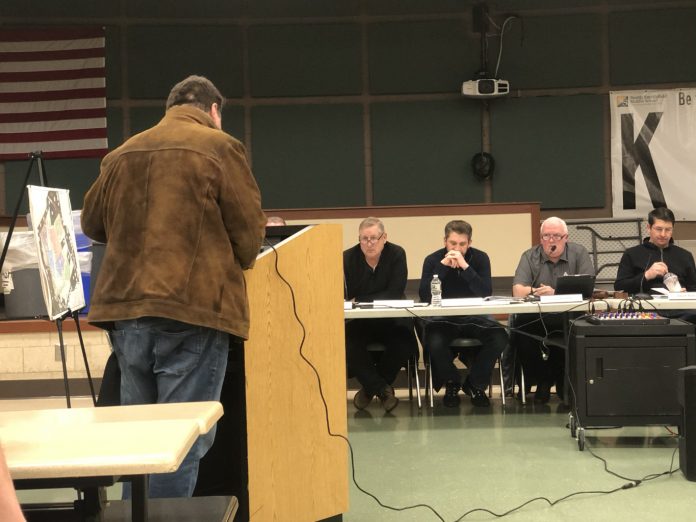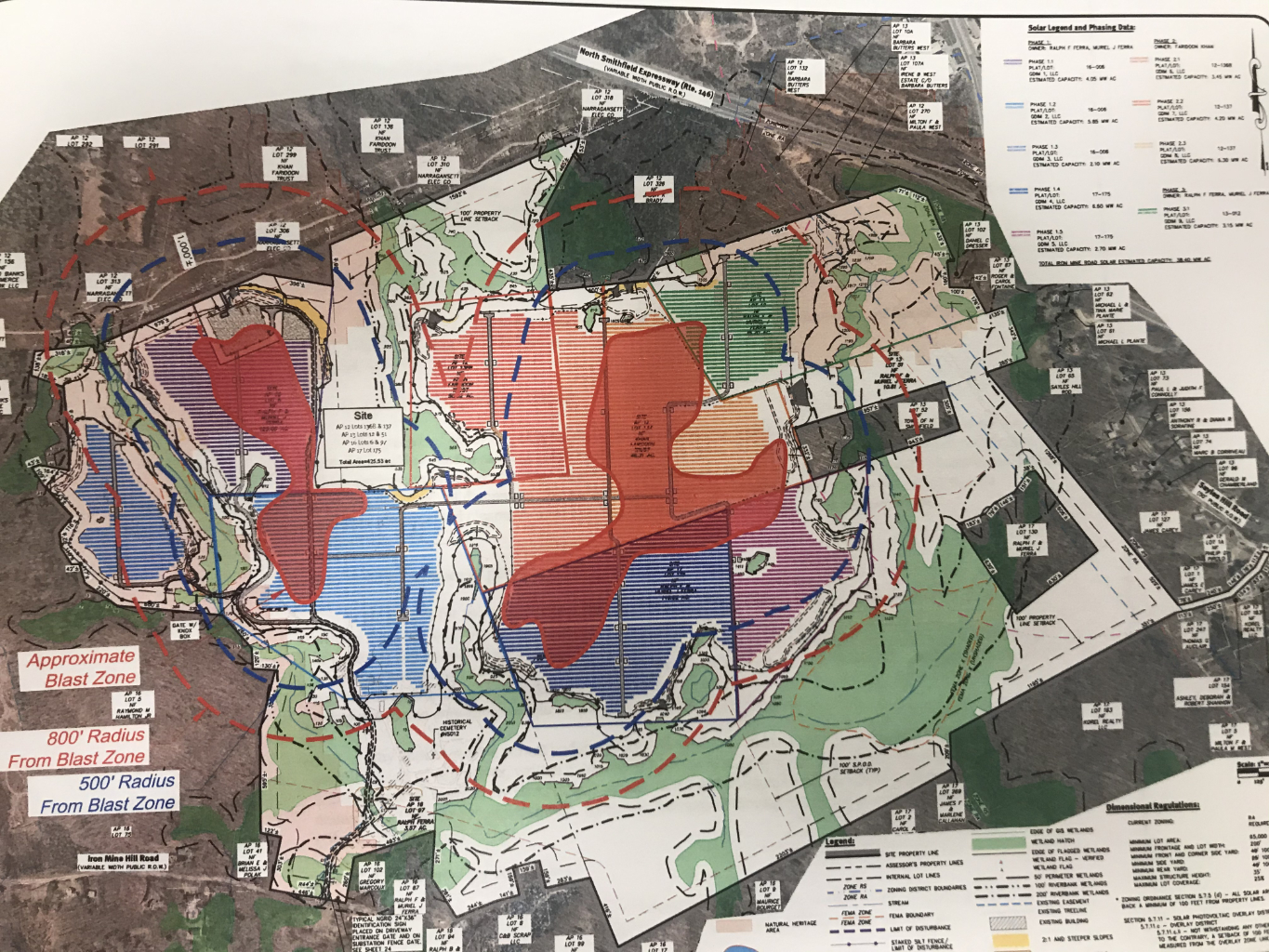
NORTH SMITHFIELD – The preliminary green light comes with a long list of conditions, but on Thursday, March 5, the Planning Board granted approval to the master plan for a massive solar project slated for Iron Mine Hill Road, with a 3-2 vote.
The meeting served as the fourth public hearing the board has held on the proposal, and a team of around a dozen lawyers, engineers and other experts with applicant Green Energy Development answered to the latest list of concerns from residents and local officials.
Among the issues with the 38.4 megawatt array, set to become one of the largest in the state, was protection of a portion of one lot that may have historical significance. The project is spread across five lots in an area known as Whortleberry Hill, and in February, an archaeologist conducting a survey of the sites found the foundation of a house, along with other potentially significant rock formations.
According to the town’s solar ordinance, developers must maintain a buffer of at least 500 feet from any historic structure.
But on Thursday, Green Energy officials did not waiver on a plans to either maintain a 25- foot setback and put up fencing, or abandon that piece of the project entirely.
“We can preserve it for you and build around it,” said Mark DePasquale, founder of Green Energy, noting his company could remove one section known at “Iron Mine 3” from the application. “It wouldn’t be cost effective to build a section in that area. We can just eliminate this section.”
Planning Board member Richard Keene noted that the proposed fencing would at least provide some protection for the historic features, while otherwise the future of the property would be unknown.
“If they don’t build it, that’s still developable land, and there’s not going to be any restriction from the property owner doing something,” Keene said.
“Nothing prevents Mr. Ferra from going in and digging out that foundation,” Keene added of the property owner.
Three lots in the 400 acres of land encompassed in Green’s solar plan are owned by Ralph and Muriel Ferra, and past uses of the land – including an auto salvage business – were also a focus of planners this week.
DePasquale noted that Ferra has plans to phase out the business, and said that in addition to cleaning up that area, his company plans to remove containers where the owner is currently storing explosives.
“The property is getting cleaner as we go,” DePasquale said. “You wouldn’t be dealing with either of those situations.”
The Rhode Island Historic Preservation Commission submitted a letter to planners this week regarding the recently discovered foundation, noting that, “the significance of the site in reference to eligibility remains undetermined.”
“They elected not to make a decision,” said Town Planner Tom Kravitz. “They’re leaving it up to you to follow your local ordinances.”
Planner Jeffrey Porter said he was inclined to demand the 200-foot setback, noting that the board is setting precedence for future solar proposals.
“I think we want to make sure we stay within regulations,” Porter said. “We need to make sure our regulations are adhered to.”
Planning Board Chairman Gary Palardy also expressed concern for preservation.
“You’re putting in something that typically has a life expectancy of 25 years,” Palardy told developers. “Removing something is permanent. Decades matter. Every time we cut down one of those trees we’re cutting down something that’s over 100-years-old. Anything that’s destroyed can’t be fixed.”
Palardy noted that in addition to the foundation, the recent survey uncovered stone blocks that look as though they might be the foundation of a barn, along with other structures that could have Native American origins.
“What can be done to protect the entire historical site?” Palardy asked.
But Green attorney John Mancini contended that since the property has not been designated as historical by the state commission, he believes the setback rule does not apply.
The list of concerns addressed Thursday also included requests from Woonsocket Water Supt. Mark Viggiani. Viggiani submitted a letter on the project this week, pointing to concerns about a reservoir around a mile from the site that serves as a source of drinking water for customers in both Woonsocket and North Smithfield.
While the developer agreed to many of the precautionary measures requested by the city water official, the group rejected the idea of increasing the buffer zone between ground-mounted solar panels and a swamp that feeds into the reservoir from 25 to 200 feet, noting that the change would cut into an area slated for solar panels, and would require resubmission of the project to the Rhode Island Department of Environmental Management for permitting changes.
“They’re asking you to do something other than what DEM requires,” said Kravitz of Woonsocket’s request.
Planners also noted the need for extended soil testing in the area where Ferra has operated an auto salvage business, and a caveat that no pesticides or herbicides be used in connection with the project.
But underlying the proceedings was one town ordinance limiting how planners could move forward: a Solar Overlay District implemented by the Town Council in 2018. The ordinance allows solar projects situated within the designated district to skirt certain zoning requirements and means the Green Energy project will not appear before the Zoning Board.
Town Solicitor David Igliozzi said Thursday that the 2018 passage of the overlay district ordinance also made the project automatically consistent with the town’s comprehensive plan, and that the district’s overlay rules now take precedent over any other inconsistencies with town law.
“This is an overlay district with its own set of rules and regulations,” Igliozzi said.
“We actually have a little less that we can hang our hat on than all other projects that come before us,” noted Palardy.
Language in the ordinance, planners noted, was written by Mancini, a statement Igliozzi clarified.
“Anyone can file a petition to have a zoning ordinance changed,” the solicitor said. “The applicant wrote it pursuant to rights under state law.”
Porter noted that town residents in the area have testified that they’ve seen additional wildlife in the area since the clear-cutting of trees for the project began last month, questioning damage to habitat.
“There hasn’t been any evidence that this would impact the wildlife,” Mancini responded.
After three years of watching proceedings, it seemed on Thursday residents of the area were displeased, but resigned.
“I’ve got two small kids and I don’t want to raise them on a solar farm,” said Chris Carpentier during the hearing. “They’re not making land anymore and we have a great town here.”
Resident Mike Rapko said he felt the company’s plan for blasting during construction should have been more transparent.
“It was never approached over the past year,” said Rapko. “It should have been presented.
“Now, in the final stages, we learn of blasting,” said Rapko, noting that blasting will be used in 30 percent of the project area. “I don’t think the public knows the extent of it.”

Mancini responded that, “Blasting wasn’t a secret. There was significant discussion at the town council of blasting.”
Among the many conditions ultimately passed with preliminary approval of the plan was a requirement that wells within 1,000 feet of blasting be tested for contamination, both before and after the activity. The Conservation Commission will be allowed to visit the property annually, and Pare Engineering will serve as a third-party monitor of the agreement, representing the town.
Porter said he would also like the property owner to consider establishing a conservation easement on the historic portion of the land.
A vote to accept the master plan with conditions passed by a 3-2, with Porter and Palardy in the minority.









